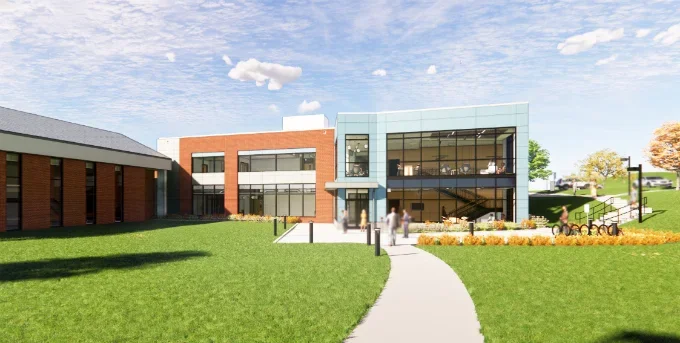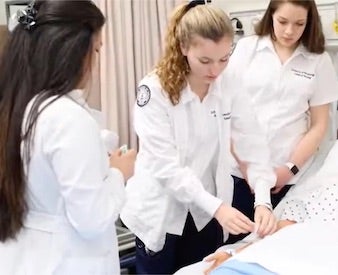
The new Life Sciences Building at the University of Pittsburgh at Greensburg is a two-story, 32,085 square-foot facility which houses labs for nursing, health science, biology, microbiology, and chemistry - along with faculty offices and shared study space.
Construction on the building began in September 2021 and was completed in December 2022. The facility is open for classes as of the Spring 2023 semester.
Building Features
"Adding new labs in the Life Science Building will provide more space for our faculty and students to not only offer lab-based courses but to also work on capstone and honors projects. We are excited to see how our students and biology program advance with the opening of the Life Science Building."
- Barbara Barnhart, MEd, Instructor of Biology
The Life Sciences Building was designed by Pittsburgh-based MCF Architecture. Rycon Construction (Pittsburgh) served as the general contractor for the project. The $19.5 million building is connected through a new chemistry wing to Smith Hall, which has served as the center for science-related education since its construction in the 1970s.
The facility features laboratory spaces for:
- anatomy & physiology
- general biology
- microbiology
- analytic chemistry
- general/advanced chemistry
- organic chemistry
along with a chemistry prep space/research area for faculty.
In addition, specific spaces for Nursing education in the building include:
- clinical lab
- simulation suite
- telehealth room
- computer lab
Learn more about named spaces in the building »
The construction of the Life Sciences Building contributed an estimated $3 million in economic output to the region's economy and an estimated 125 non-permanent direct jobs. In addition, 31 permanent direct jobs will be created or retained and 112 jobs will be indirectly supported.
Why A New Life Sciences Building?
"This project demonstrates Pitt-Greensburg's commitment to excellence in academics. Our goal is to provide quality educational opportunities for our students, enabling them to graduate and fill the growing vacancies among regional and state healthcare providers and other high priority STEM occupations."
– Robert Gregerson, PhD, President of Pitt-Greensburg
Who will take care of you in the next ten years?
 Today, there are more Americans over the age of 65 than at any other time in U.S. history. Between 2010 and 2030, the population of senior citizens will increase by 75 percent; one in five Americans will be a senior citizen. ("The US is running out of nurses," The Atlantic, February 3, 2016)
Today, there are more Americans over the age of 65 than at any other time in U.S. history. Between 2010 and 2030, the population of senior citizens will increase by 75 percent; one in five Americans will be a senior citizen. ("The US is running out of nurses," The Atlantic, February 3, 2016)
More than 290,000 Baby Boomers in Pittsburgh's tri-state region are eligible to retire in the next decade. This will result in a significant shortage of skilled employees across sectors including:
- IT
- business and finance
- healthcare and life sciences
- energy
- advanced manufacturing
In this timeframe, economic growth is expected to create 50,000 new positions, adding up to nearly 340,000 open jobs.